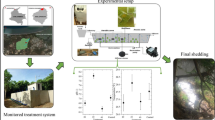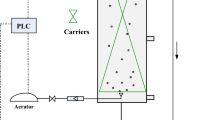Abstract
Successful elimination of high concentrations of N–NO −x (up to 250 mg/L) from high salinity wastewaters (up to 35 g/L Cl− + 17 g/L SO4 2−) originating from desulphurization process within coal power stations was achieved using pure cultures of denitrifying bacteria encapsulated in porous polyvinyl alcohol lenses (so called Lentikats Biocatalyst, LB). Laboratory batch tests revealed inhibitory influence of the raw wastewater on the denitrification activity, which was partially mitigated by the addition of P–PO4 3−. In following continuous tests, the denitrification activities reached the range 150–450 mg N/h/kg LB, i.e., values suitable for industrial scale applications. The higher activities were achieved under a lower salinity, higher N–NO −x influent concentrations and a prolonged retention time. The effluent N–NO −x concentrations were below the determination limit of 5 mg/L. After a period of 3 months, a significant decrease of denitrification activity of Lentikats Biocatalyst was observed. Addition of nutrients into the wastewater enabled fast regeneration of the initial activity. The overall results proved the applicability of Lentikats Biocatalysts for the removal of nitrates from high-salinity desulphurization water and other industrial wastewaters of similar character.



Similar content being viewed by others
References
Beliavski M, Meerovich I, Tarre S, Green M (2010) Biological denitrification of brines from membrane treatment processes using an upflow sludge blanket (USB) reactor. Water Sci Technol 61(4):911–917
Bouskova A, Mrakota J, Stloukal R, Trogl J, Pilarova V, Kriklavova L, Lederer T (2011) Three examples of nitrogen removal from industrial wastewater using Lentikats Biotechnology. Desalination 280(1–3):191–196
Bruss T, Mika D, Westermann B, Warnecke HJ (2002) Enantioselective hydrolysis of racemic epoxides with LentiKats((R))-encapsulated microorganisms. In: Landbaufor. Volkenrode, SH241, pp 127–129
Cyplik P, Grajek W, Marecik R, Kroliczak P, Dembczynski R (2007) Application of a membrane bioreactor to denitrification of brine. Desalination 207(1–3):134–143
Dincer AR, Kargi F (1999) Salt inhibition of nitrification and denitrification in saline wastewater. Environ Technol 20(11):1147–1153
Ersever I, Ravindran V, Pirbazari M (2007) Biological denitrification of reverse osmosis brine concentrates: I. batch reactor and chemostat studies. J Environ Eng Sci 6(5):503–518
Estuardo C, Marti MC, Huilinir C, Lillo EA, Von Bennewitz MR (2008) Improvement of nitrate and nitrite reduction rates prediction. Electron J Biotechnol 11(3). doi:10.2225/vol11-issue3-fulltext-6
Foglar L, Sipos L, Bolf N (2007) Nitrate removal with bacterial cells attached to quartz sand and zeolite from salty wastewaters. World J Microbiol Biotechnol 23(11):1595–1603
Glass C, Silverstein J (1998) Denitrification kinetics of high nitrate concentration water: pH effect on inhibition and nitrite accumulation. Water Res 32(3):831–839
Glass C, Silverstein J (1999) Denitrification of high-nitrate, high-salinity wastewater. Water Res 33(1):223–229
Grosova Z, Rosenberg M, Rebros M, Sipocz M, Sedlackova B (2008) Entrapment of beta-galactosidase in polyvinylalcohol hydrogel. Biotechnol Lett 30(4):763–767
Grosova Z, Rosenberg M, Gdovin M, Slavikova L, Rebros M (2009) Production of D-galactose using beta-galactosidase and Saccharomyces cerevisiae entrapped in poly(vinylalcohol) hydrogel. Food Chem 116(1):96–100
Hanaki K, Hirunmasuwan S, Matsuo T (1994) Protection of methanogenic bacteria from low pH and toxic materials by immobilization using polyvinyl-alcohol. Water Res 28(4):877–885
Hronska H, Grosova Z, Rosenberg M (2009) Hydrolysis of lactose in milk by Kluyveromyces lactis beta-galactosidase immobilized in polyvinylalcohol gel. J Food Nutr Res 48(2):87–91
Jekel M, Buhr A, Willke T, Vorlop KD (1998a) Immobilization of biocatalysts in LentiKats. Chem Eng Technol 21(3):275–278
Jekel M, Buhr A, Willke T, Vorlop KD (1998b) Novel gel inclusion immobilisation systems (LentiKats) in biotechnology. Chem Ing Tech 70(4):438–441
Kriklavova L, Lederer T (2010). The use of nanofiber carriers in biofilm reactor for the treatment of industrial wastewaters. In: Nanocon 2010, 2nd International Conference, pp 165–170
Kubac D, Cejkova A, Masak J, Jirku V, Lemaire M, Gallienne E, Bolte J, Stloukal R, Martinkova L (2006) Biotransformation of nitriles by Rhodococcus equi A4 immobilized in LentiKats (R). J Mol Catal B Enzym 39(1–4):59–61
Lefebvre O, Moletta R (2006) Treatment of organic pollution in industrial saline wastewater: a literature review. Water Res 40(20):3671–3682
Mariangel L, Aspe E, Marti MC, Roeckel M (2008) The effect of sodium chloride on the denitrification of saline fishery wastewaters. Environ Technol 29(8):871–879
Mcadam EJ, Judd SJ (2008) Biological treatment of ion-exchange brine regenerant for re-use: a review. Sep Purif Technol 62(2):264–272
Mcadam EJ, Pawlett M, Judd SJ (2010) Fate and impact of organics in an immersed membrane bioreactor applied to brine denitrification and ion exchange regeneration. Water Res 44(1):69–76
Mohseni-Bandpi A, Elliott DJ (1998) Groundwater denitrification with alternative carbon sources. Water Sci Technol 38(6):237–243
Park EJ, Seo JK, Kim MR, Jung IH, Kim JY, Kim SK (2001) Salinity acclimation of immobilized freshwater denitrifier. Aquacult Eng 24(3):169–180
Pilarova V, Trogl J, Synek V (2011) Validation of photometric determinations of nitrites and CODCr using Spectroquant® sets in saline waters. Chem Listy 105(13):s55–s57
Rebros M, Rosenberg M, Kristofikova L, Stloukal R (2005a) Microbial production of fuel ethanol: Bacteria or yeasts? Chem Listy 99(6):402–409
Rebros M, Rosenberg M, Stloukal R, Kristofikova L (2005b) High efficiency ethanol fermentation by entrapment of Zymomonas mobilis into LentiKats((R)). Lett Appl Microbiol 41(5):412–416
Rebros M, Rosenberg M, Grosova Z, Kristofikova L, Paluch M, Sipocz M (2009) 170 Ethanol Production from Starch Hydrolyzates using Zymomonas mobilis and Glucoamylase Entrapped in Polyvinylalcohol Hydrogel. Appl Biochem Biotechnol 158(3):561–570
Sievers M, Schafer S, Jahnz U, Schlieker M, Vorlop KD (2002) Significant reduction of energy consumption for sewage treatment by using LentiKat (R) encapsulated nitrifying bacteria. In: Landbaufor. Volkenrode SH241, pp 81–86
Trogl J, Bouskova A, Mrakota J, Pilarova V, Krudencova J, Mechurova J, Krizenecka S, Stloukal R (2011a) Removal of nitrates from simulated ion-exchange brines with Paracoccus denitrificans encapsulated in Lentikats Biocatalyst. Desalination 275(1–3):82–86
Trogl J, Bouskova A, Pilarova V, Mrakota J, Stloukal R (2011b) Application of Lentikats Biotechnology for removal of nitrates from ion-exchange brines: Implications for adaptation of encapsulated denitrifiers. Afr J Biotechnol 10(79):18304–18310
Vackova L, Srb M, Stloukal R, Wanner J (2011) Comparison of denitrification at low temperature using encapsulated Paracoccus denitrificans, Pseudomonas fluorescens and mixed culture. Bioresour Technol 102(7):4661–4666
Vejvoda V, Kaplan O, Klozova J, Masak J, Cejkova A, Jirku V, Stloukal R, Martinkova L (2006) Mild hydrolysis of nitriles by Fusarium solani strain O1. Folia Microbiol 51(4):251–256
Vorlop KD, Jekel M (1999) Process for preparing a biocatalyst with a polyvinyl alcohol gel and biocatalyst produced by this process. German patent DE 198(27):552
Wisniewski C, Persin F, Cherif T, Sandeaux R, Grasmick A, Gavach C, Lutin F (2002) Use of a membrane bioreactor for denitrification of brine from an electrodialysis process. Desalination 149(1–3):331–336
Yang PY, Nitisoravut S, Wu JS (1995) Nitrate removal using a mixed-culture entrapped microbial cell immobilization process under high-salt conditions. Water Res 29(6):1525–1532
Acknowledgments
This work was co-funded by the Ministry of Education, Youth, and sports of the Czech Republic (project 1M0554), LentiKat’s Inc., Prague and the Internal Grant Agencies of J. E. Purkyně University and Technical University in Liberec (project 7824/115).
Author information
Authors and Affiliations
Corresponding author
Rights and permissions
About this article
Cite this article
Trögl, J., Krhůtková, O., Pilařová, V. et al. Removal of nitrates from high-salinity wastewaters from desulphurization process with denitrifying bacteria encapsulated in Lentikats Biocatalyst. Int. J. Environ. Sci. Technol. 9, 425–432 (2012). https://doi.org/10.1007/s13762-012-0048-4
Received:
Revised:
Accepted:
Published:
Issue Date:
DOI: https://doi.org/10.1007/s13762-012-0048-4




